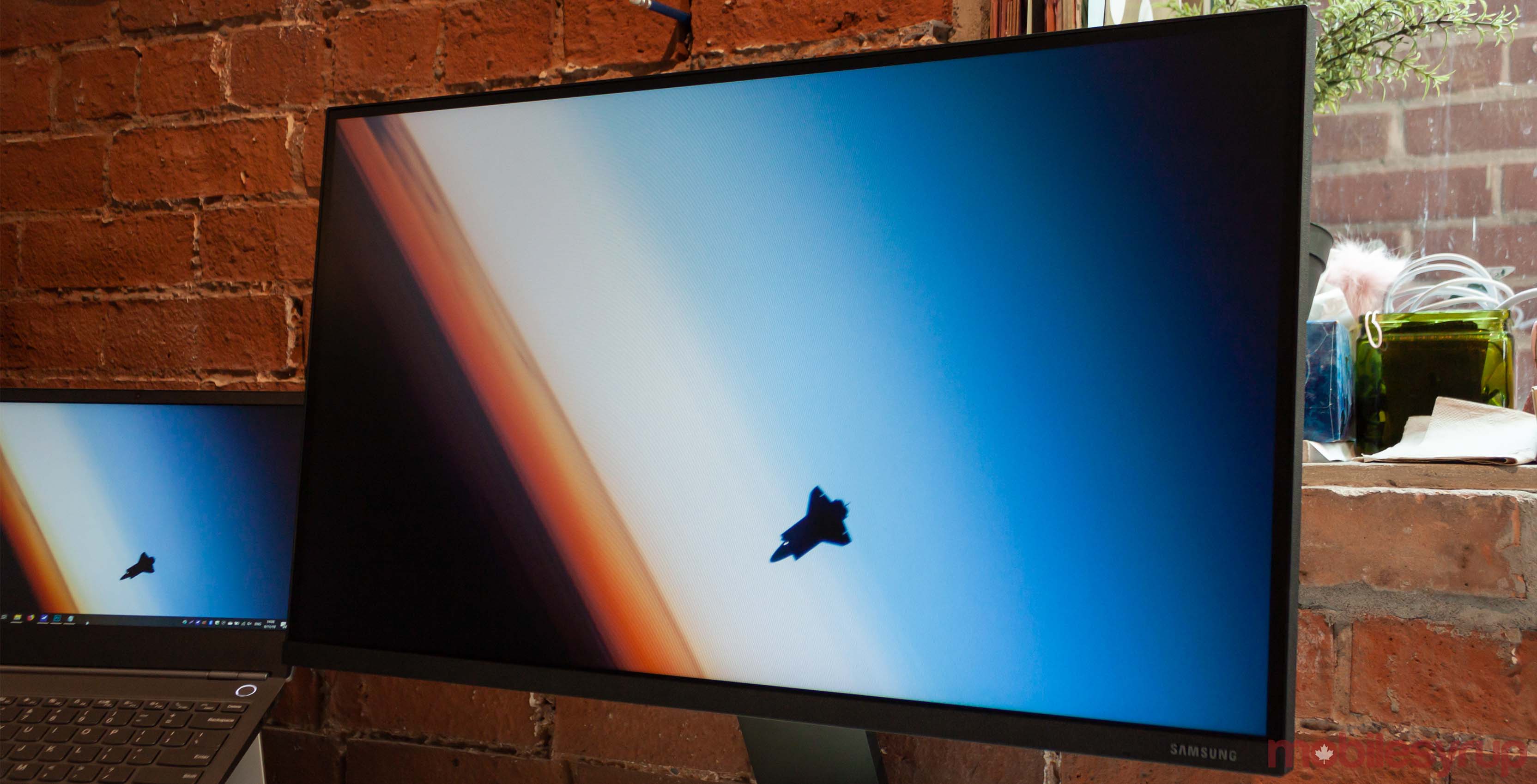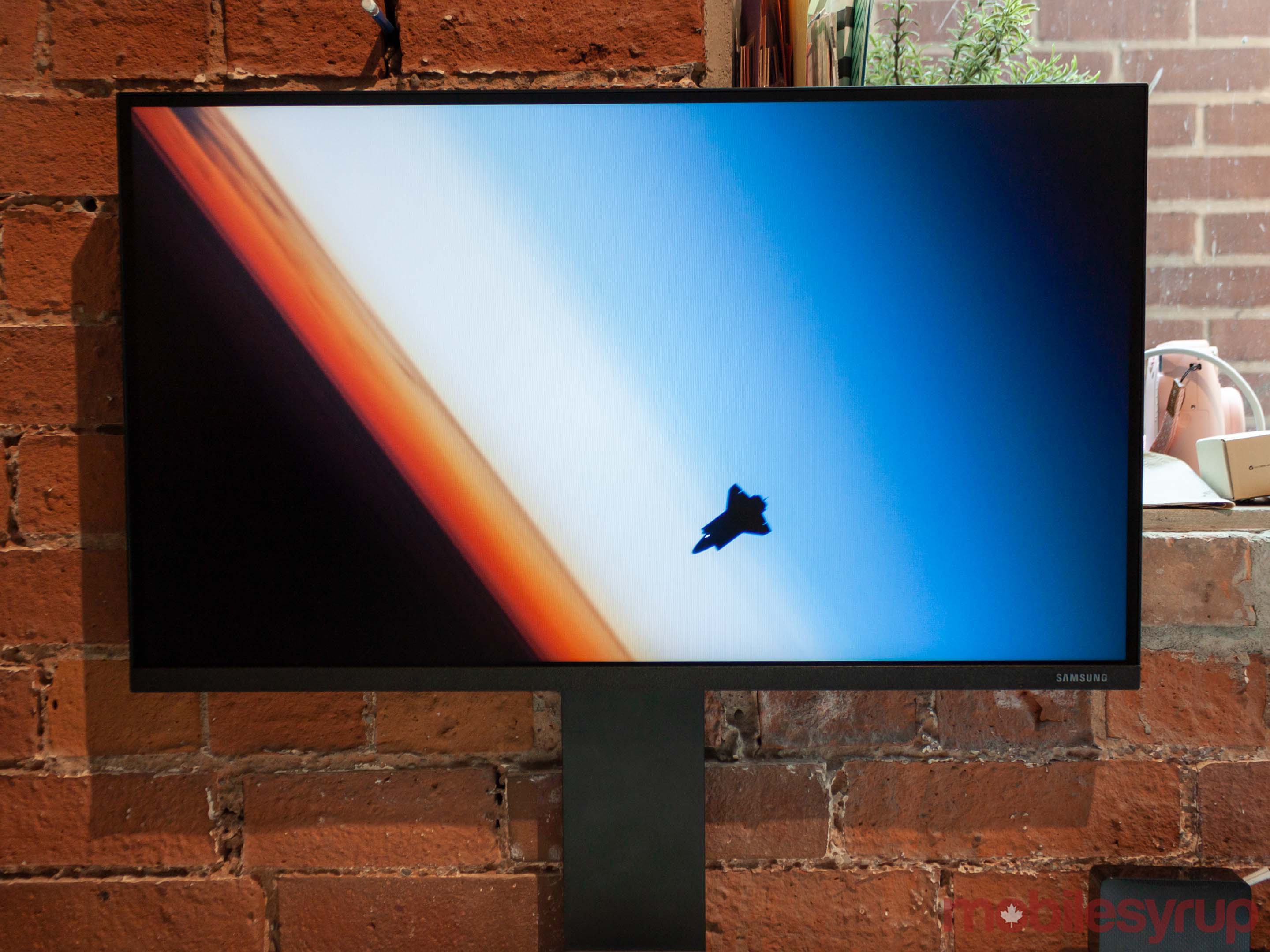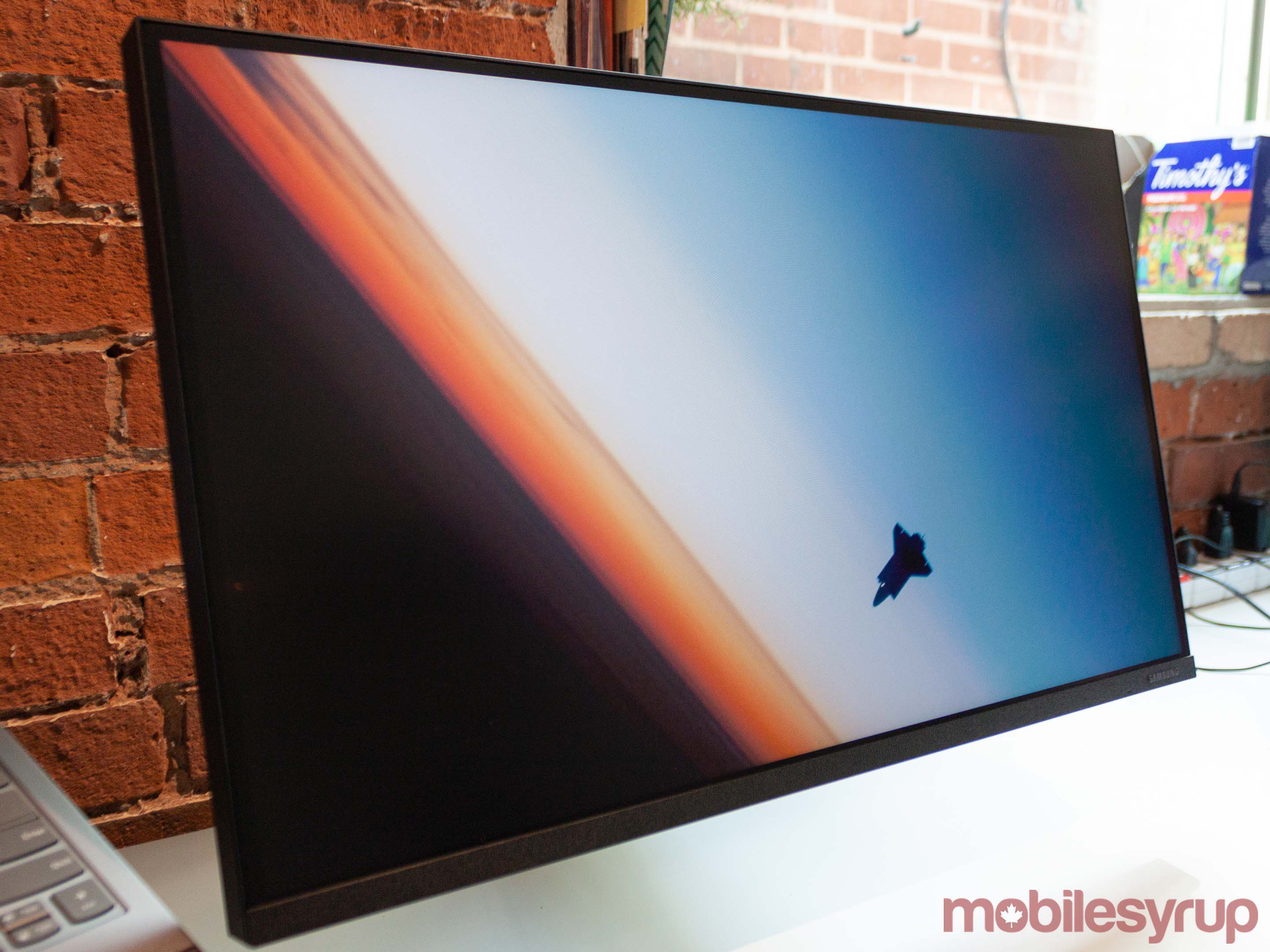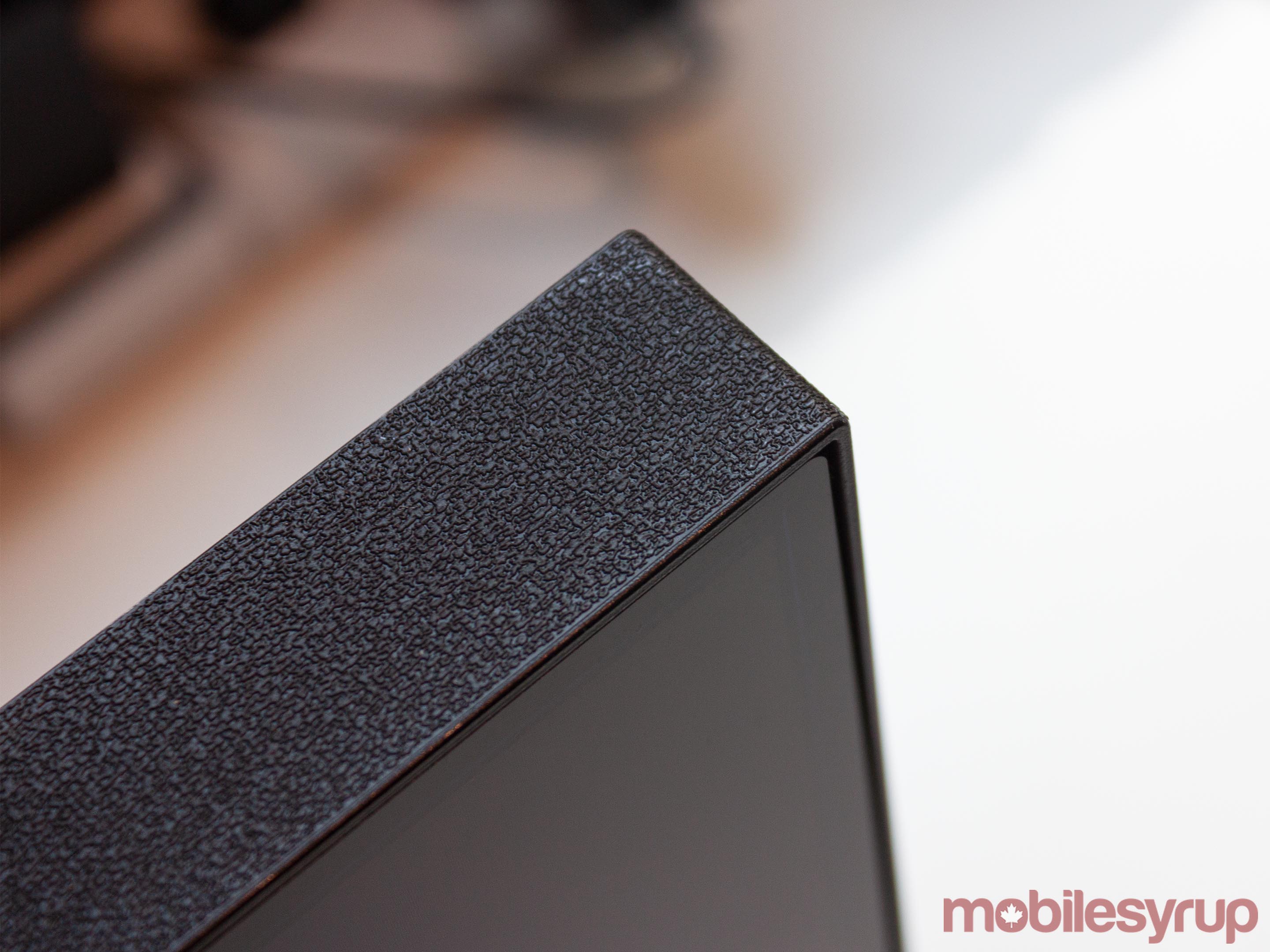
You’ve likely seen Samsung’s Space Monitor floating around online, either through announcement posts or fancy GIFs of it pivoting up and down. Like many, I saw these and was immediately taken with the monitor. It seemed an ingenious idea: a display with a stand that clamps on the side of your desk, out of the way, that can pivot and shift to meet your every need.
While the monitor is full of promise, some things just don’t live up to the hype. Samsung’s Space Monitor is one of those things that may not be as good as it seems.
Samsung recently sent over one of the smaller 27-inch Space Monitors for me to try out. I’ve been using it as my dedicated second screen in the office for about a week and a half. In short, the display is excellent, the stand is nice and overall it was a welcome addition to my desk.
Bless the desk with ?SPACE?

When the monitor arrived, I was startled by the sheer size of the box. For a 27-inch display, the box was quite long. However, when I unpacked it, it made sense. The length comes from the stand, which consists of a clamp to attach to your desk and an arm.
It’s worth noting that assembly will probably require another person to hold the monitor. You’ll need to screw the arms onto the mounting bracket on the backside of the display before clamping it to your desk. That means you need to hold the monitor in place until the clamp is secure, or it’ll fall over.
Once secured, you can then manipulate the monitor, which can hinge up and down on the arm and tilt accordingly. Want to lower it down so it sits on the surface of the desk? You can! Want to lift it up flush against the wall? You can do that too.
One thing you can’t do, however, is swivel the monitor. The Space Monitor only moves along the vertical axis, so if you want to adjust the angle of it, you’re out of luck. This ultimately proved to be one of the biggest issues I had with the monitor, but how much of a problem it is depends on your setup.
In my case, my desk is quite thin, but is really wide. Typically, I use a second monitor that’s off to the side so I can maximize the depth and have a comfortable typing position. Unfortunately, that wasn’t an option with the Space Monitor, as I couldn’t rotate the screen and have it placed to the side.
Thankfully the monitor is quite tall, so I was able to place my laptop beneath it and work with a vertical monitor stack. This wasn’t ideal, but still tolerable. Again, the swivel likely isn’t a significant issue but, depending on your desk setup, could make or break your experience with this monitor.
Space Monitor surrenders your desk to other clutter

When you consider that you can pick up a basic desktop monitor mount, complete with a clamp and features like swivel, for close to $30 on Amazon, it’s hard to argue that the Space Monitor brings anything unique to the table.
Samsung’s system is refined and it’s nice to have an all-in-one system, but when that means it costs $50 to $100 or even more than most comparable monitors, then it becomes harder to justify.
Worse, the Space Monitor arguably doesn’t accomplish its biggest claim. In almost all of Samsung’s marketing, it touts the monitor’s ability to tidy up your workspace as a major plus. Practically, I found the monitor didn’t free up more deskspace at all.
Granted, the Space Monitor’s stand is smaller and takes up less space than the average monitor base, but that alone doesn’t provide significantly more space. Where Samsung claims the monitor really saves space is in its ability to sit flush against the wall. In theory, this does free up desk space as it gets the monitor out of the way so you can utilize almost the whole desk for other tasks. In practice, it doesn’t quite work out. When you move the monitor out of the way, you’ll still have other items like the keyboard, mouse or, if you use a laptop, the computer on your desk. Sure, these things can easily be moved out of the way, especially if they’re wireless, but that doesn’t make the Space Monitor any more adept at saving space.

It’s a nitpick really, but I think it’s important to clarify that if you’re buying the Space Monitor, it isn’t because it’s going to free up space on your cluttered desk. It won’t. If anything, the monitor invites more clutter by minimizing the stand. Compared to my other, regular monitor, I have more cable clutter because I can no longer tuck it out of sight behind the monitor stand.
That said, the Space Monitor does offer two cable management solutions. The first is a divet that runs down the back of the stand’s arm to hide the display cable. The second cable management solution is that the power and display cable the monitor comes with are one unit. At one end, you have an HDMI head and a power-in for the monitor. About half-way along the cable, the power splits off so you can route it to an outlet and keep the display cable going to the input on your computer. It’s a smart solution that, unlike other aspects, actually offers some space savings.
Additionally, the monitor only has a single HDMI-in and Mini DisplayPort-in for ports, along with a ‘Service’ USB-A port. In other words, users will be quite limited in options for connecting the Space Monitor to a device. Granted, the ubiquity of HDMI makes this a non-issue, but it’d be nice to see more options like USB-C.
If you buy the Space Monitor, it’s for the screen

If you’re going to fork out the money for the Space Monitor, you’re probably doing it for that crisp Samsung display.
The Space Monitor comes in two variants: the 27-inch ‘WQHD’ 2560 x 1440 pixel resolution display and the 32-inch ‘UHD’ 3840 x 2160 pixel resolution screen (also known as 1440p and 4K options). Additionally, both screens sport 16:9 aspect ratios, 250cd/m2 brightness and a 4m/s response time. Other than resolution and size, there are only a few real differences. Contrast, for one, with the 1440p monitor sporting a 3000:1 contrast ratio compared to 2500:1 on the 4K screen. Refresh rate is another, as the 27-inch monitor has a 144Hz refresh rate compared to the 32-inch version’s 60Hz. The other major difference is, of course, price, with the smaller screen coming in at $599.99 and the bigger at $699.99.
While I can only speak for the 27-inch screen, I can say that the colours were fantastic and the picture was crisp. All in all, Samsung’s display technology is fantastic and it’s hands down one of the best monitors I’ve used in that regard. The high refresh rate screen was also a welcome addition, even though I didn’t get to use the monitor for any gaming while I was testing it.
For things like photo editing and general productivity, the monitor was fantastic. I never had to worry about messing up the colours in my photos, and the display provided more space to spread out my work.
The only real issue I had in terms of colour was when I tested the display with a MacBook Air. Apple’s True Tone display software, when enabled, caused the Space Monitor to take on an awful red tint. Fixing it was as simple as turning off True Tone, but it was a minor annoyance I would have preferred not to deal with.
A superb display that won’t magically clean up your desk

Unfortunately, not all dreams are reality and the Space Monitor, while excellent, manages to miss a few important beats. There seems to be a trend in the industry of computer monitors where companies create excellent displays then jack up the prices based on a fancy included stand. The Space Monitor is not as egregious as other displays, like Apple’s exorbitant Pro Display XDR and Pro Stand combo — the Space Monitor thankfully comes with its own stand. But it follows the same principles: Samsung designed its monitor around a fancy stand with mechanics to allow for a gentle hinge for easy adjustment, raised the price above equivalent displays and marketed it accordingly.
Suffice it to say that the Space Monitor, by no merit of its own, saves any space on your desk. Sure, it reduces the footprint of the monitor stand but if that was the sole cause of your workspace clutter, did you even really have a need to save space?
Nor does the Space Monitor justify its higher price through space savings or any other practical benefit.
These things don’t necessitate that the Space Monitor is bad. By all counts, it’s an excellent display and I think the concept is solid. If you want a quality Samsung display with a unique stand and cool aesthetic, the Space Monitor is for you. If you’re hoping to magically solve your clutter problems, you should look elsewhere. Oh, and if you just need a decent monitor and all that matters is the display, plenty of companies — including Samsung — make comparable displays without the space-saving gimmicks.
MobileSyrup may earn a commission from purchases made via our links, which helps fund the journalism we provide free on our website. These links do not influence our editorial content. Support us here.


